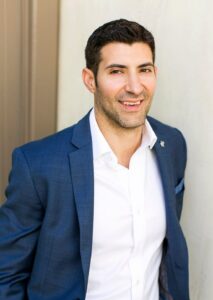An Interview With Fotis Georgiadis
…I feel that that the most critical role of a leader during challenging times is find the hidden power of behavior science to understand the art of science of people’s behaviors, attitudes, and systems to be able to see and understand the interconnections and interconnectedness of the business to make dynamic decisions.
As part of our series about the “Five Things You Need To Be A Highly Effective Leader During Turbulent Times”, we had the pleasure of interviewing Dr. Debbie Sutherland.
Dr. Debbie Sutherland is an academic executive with over twenty years of global work experiences in Canada, Southeast Asia, Europe, and the Middle East. She is continually learning about the dynamics and hidden power of adult learning, organizational behaviors and systems thinking through the business lens.
She has worked in a variety of centralized roles in complex adaptive systems and international start-up organizations and is currently living and working as an executive in the UAE. She specializes in setting up the ideal structure, culture, and people-centric programs to enable leaders to thrive in the workplace.
Debbie has completed her Doctor of Education in adult learning and organizational leadership and an executive master’s degree in socio-organizational psychology, each from Columbia University, and is a certified executive coach.
Thank you so much for your time! I know that you are a very busy person. Our readers would love to “get to know you” a bit better. Can you tell us a bit about your ‘backstory’ and how you got started?
I have always wondered about how people think. I was curious about what each of us was thinking that got us to this place.
I had the great privilege to work in centralized positions within different large scale start up organizations in various countries. I noticed firsthand how some executives differ widely in their understanding of and comfort level on an ambiguity spectrum. Some executives are on one side of the spectrum and avoid ambiguity and the cognitive stress that uncertainty brings. They ignore nuances when faced with too many opportunity streams and simply make fast, decisive decisions or feel anxious when they can’t see which path is better; sometimes they stall decision-making until they get more information. Conversely, on the other side of the spectrum, some executives build a tolerance for ambiguity situations by learning different coping mechanisms.
I wanted to know what propels some people to see an ill-defined decision-making path better than others. Why are some people more comfortable working in ambiguous situations, while others react negatively? Why are some people more comfortable working in ambiguous situations, while other people react negatively?
These questions become my research for my book The Business of Ambiguity. I wanted to know the executives’ thinking and behavior patterns; I wanted to know how they learned this skill, and what elements helped them make good decisions when they encountered situations they’d never experienced before, when immersed in confusion, power struggles from ill-defined policies and deeply entrenched conflicting views.
Can you share a story about the funniest mistake you made when you were first starting? Can you tell us what lessons or ‘take aways’ you learned from that?
Learning to become a leader during turbulent times is a humbling experience. Who hasn’t been challenged to solve a workplace conflict, try to build trust within a diverse or remote working team, deal with a strategic growth dilemma or need to investigate a troublesome behavior issue at work with a co-worker? The illusive leadership capacity is built on a series of uncomfortable learning moments, events, and experiences.
However, to learn from past events, you need to be able to reflect on those moments with a sense of curiosity and of course, humbleness, to be able to find the funny in the mistakes. In my case, I find organizational behaviors ever changing and with a healthy HR sense of ‘you can’t make up what just happened’ thinking, human behavior can be funny at times.
Thus, a key lesson I have learned when working within complex adaptive systems, when there is always a messy situation at hand, is that you don’t need to be the ‘smartest person’ in the room when something unexpected happens. We are ALL shocked and wondering, “What the heck is the next step going to be?” I have found that to able to find the humor in mistakes, is to try to find the good, funny, or at least interesting within every experience.
There is a great theory called the Planned Happenstance Learning Theory, developed by Stanford professors John Krumboltz and Al Levin. The goal of the research was to examine new events as opportunities and to discover what’s possible when students are in the right place at the right time with the right tools. They found that five traits best helped students during ambiguous situations: curiosity, persistence, flexibility, optimism, and risk taking (Krumboltz & Levin, 2004).
Thus you can keep your sense of humor, be humble, have curiosity, and learn from your mistakes when dealing with our messy world.
None of us are able to achieve success without some help along the way. Is there a particular person who you are grateful towards who helped get you to where you are? Can you share a story?
I didn’t have an official mentor per se, but I did tap into some wonderful and supportive groups that were my thought partners, motivators, safety net and cheerleaders.
By seeking out liked minded groups, I was able to build my community, and feel their collective force with me. During difficult times, I often felt like I was pushing that giant boulder up the hill by myself, when in reality, I had my cohort, friends, teammates, and various club members, who were helping me with their invisible strength, support and motivation.
This is one of the key strategies in my book The Business of Ambiguity on how to think and behave when stuck in uncertain situations. When you can’t see or think your way out of a situation; you need to harness the power of the diverse network to be able to tap into the social intelligence of the group and become stronger and gain insights from the wisdom of many.
I encourage everyone to find a mentor, no matter what phase of your career you are in; or find two mentors, a colleague, and an executive coach. The point is to build a community of practice; a group of people who share a common concern and learn to interact, share skills, expertise and knowledge that build connections and informational insights.
Extensive research suggests that “purpose driven businesses” are more successful in many areas. When your company started, what was its vision, what was its purpose?
The CEO of a large scale insurtech start up asked me to join their executive team as they were launching products that would disrupt the insurance market.
To do this, the CEO was looking for someone who would be able to lead and implement various people centric programs that enable the employees to be creative and innovative.
Behavior science plays a key role in designing organizations to leverage corporate competitiveness and sustainability. In that sense, the company was focused on hiring employees who can learn how to have adaptable mental models, create collaborative links across the organization and place emphasis on a ‘continuous learning’ ethos.
How is this accomplished? Not just by incorporating a talent development department, but by creating an organization structure in which all of these concepts are spread throughout the organization and imbedded into all the systems, processes, and behaviors.
Thank you for all that. Let’s now turn to the main focus of our discussion. Can you share with our readers a story from your own experience about how you lead your team during uncertain or difficult times?
One experiences that helped shape my thinking on how to lead teams through turbulent times, was when I attended a Group Relations Conference in New York. It was not a typical conference, as this event involved ‘learning from experience’ methods to uncover group and social dynamics, to explore the uncurrent of social behaviors, assumptions, and cultural norms, and to understand how authority and power are used consciously and unconsciously in groups.
Through a series of uncomfortable learning experiences, you could begin to understand and learn how in teams and groups, we are immersed in one another’s identity, perspectives, experiences, and differences and of course, all the uncomfortable discussions regarding trust, power, authority, and biases.
And by becoming comfortable within all those group dynamics, you become able to understand how people think and act during times of ambiguity.
I have now worked for four different large scale start up organization that range from aviation, renewable energy, real estate development and now the insurtech domain. You could say that the first 18 months of each of these companies were in dynamic and fluid states of messiness. By learning about group dynamics at that conference, I can now understand the misunderstandings, paradoxes and unintentional acts that unfold regularly throughout our lives. And by becoming more humble and open to other’s perspectives, you can avoid a Hunger Games mentality and build dynamic teams who are also open to uncertainty and learning, to be able to thrive during turbulent times.
Did you ever consider giving up? Where did you get the motivation to continue through your challenges? What sustains your drive?
From my corporate experiences, there seemed to be a gap in leadership training that helps executives learn coping mechanisms during these unique and disruptive situations. Books about systems thinking, which stems from the chaos theory and decision sciences, were too complex and mathematical for main-stream businesses to embrace.
And knowledge gaps continue to be our reality. We live in a dynamic and interconnected world and making well-informed and long- term decisions have become progressively difficult, given our limited understanding of the basis of unanticipated events or unintended business consequences.
As this complexity increases, patterns of errors and system-wide problems become more difficult to predict, and even our new technologies and interconnectedness continue to complicate global businesses and executives must constantly struggle with that uncertainty to make informed decisions.
My motivation goal was to write a deeply researched but easy to read book, incorporating three theories: systems thinking, adult learning and organizational behaviors, to enable business leaders who want to expand their thinking and leadership capacity, for anyone who may want to explore a knowing gap in life or business, or for anyone who has felt that it might be time to understand your own biases and assumptions to a higher level.
What would you say is the most critical role of a leader during challenging times?
I feel that that the most critical role of a leader during challenging times is find the hidden power of behavior science to understand the art of science of people’s behaviors, attitudes, and systems to be able to see and understand the interconnections and interconnectedness of the business to make dynamic decisions.
Through my research, I developed the concept of “The Ambiguity Mindset. The Ambiguity Mindset is essentially the cognitive and behavioral capacity to reflect on, examine and adapt perspectives and to seek meaning from dynamic connections, interactions, experiences, and behaviors to determine the ideal decision pathway.
The ambiguity mindset is a way of addressing cognitive complexities and behavioral insights and a way of learning how to think and act while immersed in unfamiliar situations.
What is the best way to communicate difficult news to one’s team and customers?
If you need to communicate difficult news to one’s team or customers, it means that something is going to change. And from their perspective, it will mean — a negative change.
So consider this: People may not actually hate change, they hate ambiguity. People may be more uncomfortable with the feeling of not knowing — with ambiguous situations — rather than with the thought of change itself.
A communication plan needs to be able to address the message to everyone in different ways, through multiple mediums and through their context. If you don’t inform your team of the current reality, from their context, their minds and whispers will fill the vacuum and their narrative will become their reality.
And everyone is different. Groups of people have different values, perceptions, and attitudes. The secret ingredient to communicating with a group of people, is to get into the invisible space, where the communication, thinking and behavior patterns are located. Therefore, the communication message and plan need to be dynamic, flexible and communication needs to be frequent to address the changes.
How can a leader make plans when the future is so unpredictable?
It is a paradox. You want to be able to plan for the future when the future is relatively unpredictable.
One of the 5 key thinking and behavior strategies from my book The Business of Ambiguity is to harness the strategic power of diverse networks. This key strategy casts a bright light on how executives can work within three spheres of insight — individual, organizational, and environmental.
When I conducted the executive interviews and focus groups for my book, The Business of Ambiguity, I was honored to have such intelligent, acclaimed professionals allow me to learn about how they think and behave when immersed in confusion. It would be logical to assume, prior to the interviews, that the executives would define their ambiguity coping mechanism as simply having in-depth business acumen, or being highly skilled in strategic planning, or having merger and acquisition expertise. However, those business terms were never mentioned — not even once.
In fact, the executives’ narratives used different phrases, including the following: understand the power of connections, build a community or relationships, seek information in the network, build connections, find parallels, use direct and indirect pathways, seek nonlinear relationships, create diversity on the team, know and understand how to communicate across various groups, seek subject matter experts, seek social exchanges, understand how different cultures bring different ideas and fine the value sharing.
Why would the executives use such soft concepts to deal with seemingly risky and precarious situations, with so much at stake? The reason may lie in the innate nature of ambiguity, assumptions of strategy and how the key is to harness the strategic power of diverse networks.
Is there a “number one principle” that can help guide a company through the ups and downs of turbulent times?
There is a mountain of research regarding change management and the key steps for ensuring all employees are aware of the potential bad news or corporate change, but what you really need to pay attention to is the invisible space. The secret ingredient to understanding a business is to be into the invisible space, where the communication, thinking and behavior patterns are located.
Essentially, the way to turn information into wisdom is to incorporate a wide-angle lens to gain perspective taking which enables you to learn the components of your own behavior and thinking architecture and be able to learn within different environments. Thus, I could narrow that down to one principle “be open to new behaviors, ideas, and information and be ready to act on those new insights”.
Can you share 3 or 4 of the most common mistakes you have seen other businesses make during difficult times? What should one keep in mind to avoid that?
There are three common mistakes that executives should pay attention to during difficult time; avoid the competency trap, unmasking your ego and the illusion of control.
The thinking patterns that served the executive well in normal and routine situations are familiar and comfortable, but they may not be most effective approach in new or ambiguous situations. Moreover, even highly skilled and intelligence people who are in a role for a long time fall into something called a competency trap. This is when the executive relies too heavily on their past experiences to solve future challenges. To avoid this silo thinking, executives need to reach outside of their comfort zone and find different perspectives to create a better thinking path.
As an executive, you may find that your ego is aligned to your professional identify and understandably, this can make it hard to move away from the I perspective. Executives also have blind spots and assumptions or may be stubborn. But the sheer force of one person cannot leverage corporate success when dealing with ambiguity.
And finally, executives may have the illusion of control and have a tendency to overestimate their control of events and people. Hierarchy control is not real control. Even as an executive, you cannot control all workplace variables and all the changing behaviors of the employees. The internal systems are continually shifting; knowledge flows in and out of the organization, employees’ motivations ebb and flow, and the external environment puts pressure on static processes.
Generating new business, increasing your profits, or at least maintaining your financial stability can be challenging during good times, even more so during turbulent times. Can you share some of the strategies you use to keep forging ahead and not lose growth traction during a difficult economy?
Operating from the people centric lens, the purpose is to create a continuous learning ethos across and throughout the organization. This means to create the corporate structure that include learning as a process to enable everyone to learn how to create, retain, and transfer knowledge within, around and across the organization with the purpose of gaining experiences and knowledge. Why?
You can’t rely on what you decided in the past to address the future issue. You need to incorporate dynamic discussions and learning from experience i.e. lessons learned insights’, to create the best strategic path.
Here is the primary question of our discussion. Based on your experience and success, what are the five most important things a business leader should do to lead effectively during uncertain and turbulent times? Please share a story or an example for each.
What I have learned from my research into systems thinking, adult learning and organizational behaviors and while speaking with dozens of high-level executives who operate in conditions of ambiguity, is that there are five key thinking and behavior strategies that help you thrive and make dynamic decisions during times of ambiguity.
The first research question I posed for the book was “What are the beliefs, behaviors and principles of business executives who work in conditions of ambiguity”? This question led to the first two ambiguity thinking and behavior strategies: Create powerful insights through critical reflection and cultivate adaptable mental models. The narratives supported the link between thinking, learning and action from different experiences and influences, rather than solely from their own point of view.
The second research question “What experiences and events provide the scaffolding in the development of an ambiguity mindset” pointed to the ambiguity thinking and behavior strategy of developing comfort in the unknown. Essentially the informal learning experiences that occur in ambiguous situations that offer a strategic learning pathway. Interestingly, there were three different types of learning experiences that featured heavily from the executive narratives: become involved in ambiguity situations, be exposed to alternative ways of thinking, and be involved with people who challenge assumptions.
The third research question “What relationships, systems and elements in the environment enable executives to develop the capacity to think through ambiguity? This question provided the path to the remaining two ambiguity thinking and behavior strategies: learn through people, context and the environment and harness the strategic power of diverse networks. These elements helped build the organizational capacity and described how the social, cultural and community practices were strong influences that enabled the executives to navigate ambiguity, social context, and complexity.
These 5 key thinking and behavior strategies sound logical and straightforward to understand, but difficult to implement. My book, The Business of Ambiguity provides the tools, insights, and exercises on how you can learn these strategies for yourself, or if you are an executive, how you can implement these insights to your company for everyone to embrace.
Essentially, if you want to be able to be a highly effective leader and understand the sum of all moving parts within an organization, during good or turbulent times, you should consider embracing the 5 key thinking and behavior strategies formulated from the research methodologies conducted using systems thinking, adult learning and organizational behaviors through the business lens to learn how to make dynamic decisions during times of uncertainty.
Can you please give us your favorite “Life Lesson Quote”? Can you share how that was relevant to you in your life?
The path of least resistance and least trouble is a mental rut already made. It requires troublesome work to undertake the alternation of old beliefs. John Dewy, How We Think
This quote speaks to how the older we get, the less we should rely on our own thoughts and opinions from the premise that our reality is made up of interactions with other people’s realities, opinions, and beliefs. We can only learn and grow from understanding how we and other’s think.
How can our readers further follow your work?
Visit my website: BehaviorsinBusiness.com or purchase my newly released book The Business of Ambiguity from any global digital bookstore
Thank you so much for sharing these important insights. We wish you continued success and good health!
Dr Debbie Sutherland: Five Things You Need To Be A Highly Effective Leader During Turbulent Times was originally published in Authority Magazine on Medium, where people are continuing the conversation by highlighting and responding to this story.



